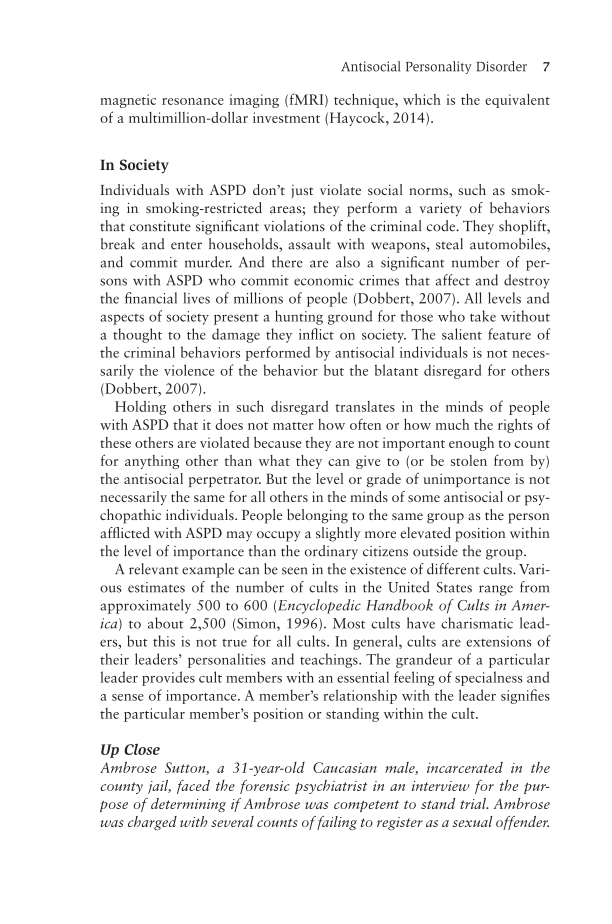Antisocial Personality Disorder 7 magnetic resonance imaging (fMRI) technique, which is the equivalent of a multimillion-dollar investment (Haycock, 2014). In Society Individuals with ASPD don’t just violate social norms, such as smok- ing in smoking-restricted areas they perform a variety of behaviors that constitute significant violations of the criminal code. They shoplift, break and enter households, assault with weapons, steal automobiles, and commit murder. And there are also a significant number of per- sons with ASPD who commit economic crimes that affect and destroy the financial lives of millions of people (Dobbert, 2007). All levels and aspects of society present a hunting ground for those who take without a thought to the damage they inflict on society. The salient feature of the criminal behaviors performed by antisocial individuals is not neces- sarily the violence of the behavior but the blatant disregard for others (Dobbert, 2007). Holding others in such disregard translates in the minds of people with ASPD that it does not matter how often or how much the rights of these others are violated because they are not important enough to count for anything other than what they can give to (or be stolen from by) the antisocial perpetrator. But the level or grade of unimportance is not necessarily the same for all others in the minds of some antisocial or psy- chopathic individuals. People belonging to the same group as the person afflicted with ASPD may occupy a slightly more elevated position within the level of importance than the ordinary citizens outside the group. A relevant example can be seen in the existence of different cults. Vari- ous estimates of the number of cults in the United States range from approximately 500 to 600 (Encyclopedic Handbook of Cults in Amer- ica) to about 2,500 (Simon, 1996). Most cults have charismatic lead- ers, but this is not true for all cults. In general, cults are extensions of their leaders’ personalities and teachings. The grandeur of a particular leader provides cult members with an essential feeling of specialness and a sense of importance. A member’s relationship with the leader signifies the particular member’s position or standing within the cult. Up Close Ambrose Sutton, a 31-year-old Caucasian male, incarcerated in the county jail, faced the forensic psychiatrist in an interview for the pur- pose of determining if Ambrose was competent to stand trial. Ambrose was charged with several counts of failing to register as a sexual offender.
Document Details My Account Print multiple pages
Print
You have printed 0 times in the last 24 hours.
Your print count will reset on at .
You may print 0 more time(s) before then.
You may print a maximum of 0 pages at a time.


























































































































































































































































